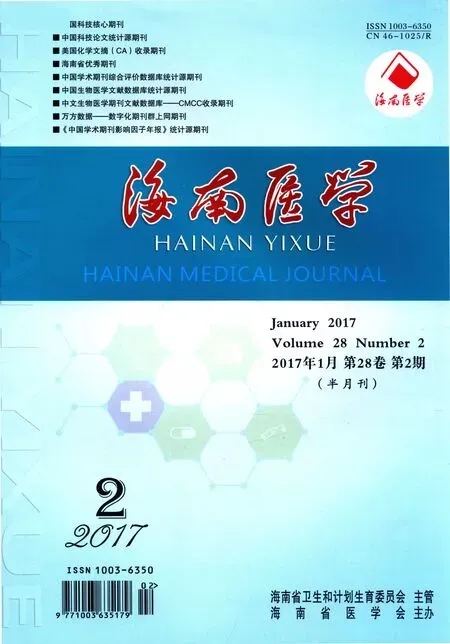膝关节周围骨挫伤诊治研究进展
尤彬,安荣泽,李松军,赵俊延
(遵义医学院第五附属珠海医院骨科,广东 珠海519100)
膝关节周围骨挫伤诊治研究进展
尤彬,安荣泽,李松军,赵俊延
(遵义医学院第五附属珠海医院骨科,广东 珠海519100)
骨挫伤是由一定暴力作用下导致皮质下骨髓水肿、出血及骨小梁断裂,进而引起局部疼痛。骨挫伤可见于全身各部位,最常见于膝关节。过去临床医生对骨挫伤的认识不够,也未引起足够重视,常以软组织挫伤来处理。但有些患者疼痛症状却长期存在,对患者生活及工作带来了极大影响。近年来由于MRI的普及,以及临床医生对骨挫伤的重视,关于膝关节周围骨挫伤的研究越来越多。但膝关节周围骨挫伤相关的治疗方案、对关节的远期影响等还未形成统一意见。鉴于此,本文就膝关节周围骨挫伤的损伤病因、发病机制、诊断标准、分型、治疗方案等做一概述,以期为临床创伤科医师做一参考。
膝关节;核磁共振;骨挫伤;骨髓水肿
骨挫伤是由一定的暴力导致皮质下骨髓水肿、出血及骨小梁断裂,松质骨微小压缩性损伤,进而引起局部疼痛[1]。骨挫伤还有很多其他名称,比如骨小梁骨折、微骨折、隐性骨折等。由于骨挫伤在皮质骨下有水肿、出血,MRI对含水物质较敏感,故在T1加权像中呈低信号,在T2加权像中呈高信号[2]。在短时间反转回复像(STRI)中呈高信号,图像呈点状或斑片状,大片状地图样或弥漫性不规则形态。骨髓水肿在脂肪抑制像中能清晰显示。国内有学者报道运用双能量CT(DECT)扫面患膝,生成虚拟去钙(VNCa)图像,并对VNCa图像上每个分区单独评级,可明确诊断骨挫伤。该方法对不能行MRI检查者有重要意义[3]。膝关节周围骨挫伤往往伴随其他器官的损伤,如半月板、交叉韧带、侧副韧带等组织的损伤,特别与前交叉韧带(anterior cruciate ligament,ACL)损伤相关性最大[4]。
1 骨挫伤分类
Mink等[5]于1989年对大量膝关节外伤患者影像资料进行统计分析后将膝关节损伤由轻至重分为4类:骨挫伤、软骨骨折、应力性骨折、胫骨近端股骨远端骨折。并对这4种损伤特点进行总结。骨挫伤患者均有急性外伤史,常见于软骨下骨,MRI表现为非线性弥散性病灶。应力性骨折患者往往有较长的病史,不常见于软骨下骨,在T1加权像中较骨挫伤范围更大,且信号更强。软骨骨折分为两类:(1)部分软骨塌陷,并未波及到松质骨髓腔;(2)软骨塌陷,并波及到松质骨髓腔。MRI可见膝关节周围骨质微小的信号改变。股骨髁或胫骨平台骨折MRI可见明显线性信号改变,往往波及关节软骨表面。
Lynch等[6]于1989年通过研究大量影像学资料后将骨挫伤分为3型。Ⅰ型:弥漫型,T1加权像呈弥散、网状的低信号位于干骺端,T2加权像表现为高信号;Ⅱ型:合并软骨与软骨下骨之间骨皮质的连续性中断信号;Ⅲ型:紧贴皮质下区的T1加权像局限性的信号减低区,而T2加权像信号无改变。Vellet等[7]于1991年对骨挫伤基于MRI影像学表现分为5型。Ⅰ型呈隐匿性网状,T1加权像干骺端骨髓呈网状图像,低信号与关节软骨面不相连,T2加权像可见高信号影;Ⅱ型为地图型,表现为信号改变与邻近的皮质或软骨下骨相连,呈地图状;Ⅲ型为线型,信号改变呈线性,宽度小于2 mm;Ⅳ型为软骨压缩型,在地图型骨挫伤且有局部软骨塌陷;V型为软骨骨折,T1加权图像上软骨骨折边缘有一些低信号,T2加权像上呈现高信号且与关节腔相通。
Bohndorf[8]于1999年根据MRI及关节镜下直视损伤部位将膝关节损伤分为两型。A型:关节软骨下骨挫伤,但软骨完整。包括两个亚型:A1关节软骨下骨挫伤,A2关节软骨下压缩性骨折。B型分为5个亚型。Terzidis等[9]根据骨挫伤部位分为2种类型:一是骨挫伤位于关节端一侧的松质骨内;第二种类型是关节两端对应部位均有骨挫伤表现,称为对吻性骨挫伤。前者约占骨挫伤的77.4%,后者约占22.6%。
膝关节骨挫伤的分型有多种,目前尚未形成统一分型。这些分型对骨挫伤的治疗、研究有一定的指导意义。
2 骨挫伤损伤机制
Shea等[10]通过回顾性研究大量患者MRI发现骨挫伤常发生于胫骨髁间嵴及股骨外侧髁。骨挫伤的常见原因是关节囊及韧带的牵拉力、垂直挤压、直接暴力、应力损伤、剪切暴力等[11]。主要病理学改变是骨髓水肿、病变区出血、骨小梁断裂[12]。骨挫伤的形式各异,骨小梁出血灶呈点状、斑片状或散在分布于骨质中。直接暴力所致骨挫伤往往造成着力处骨小梁断裂,继而发生广泛渗出,可合并肌腱、关节囊、韧带损伤。撕脱性暴力所致骨挫伤可导致肌腱或韧带附着点骨质水肿、出血。应力损伤性骨挫伤特点为:应力作用的方向与骨小梁断裂的方向垂直。剪切损伤特点为骨挫伤的出血点和水肿灶呈斜行,且边界清晰。
3 膝关节骨挫伤合并周围器官损伤
近年来国内外关于膝关节周围骨挫伤合并伤研究很多。通过骨挫伤与膝关节韧带半月板损伤的关系,可为临床医师判断膝关节损伤程度及预后提供参考,并可减小漏诊率。膝关节软骨及软骨下钝性损伤常伴交叉韧带及半月损伤[13],可激活化学性炎症反应,刺激韧带、软骨、半月板、软骨下骨细胞释放炎性细胞因子。同时关节腔积液也可能增加,导致关节疼痛。有些学者认为ACL损伤患者中70%~80%伴有骨挫伤[14]。
MRI评估ACL断裂主要依据信号改变,灵敏度高达94%,特异性接近100%[15]。某些情况下膝关节关节腔水肿掩盖了ACL断裂,使得评估困难。有学者对30例患者研究发现漏诊了4例ACL损伤,漏诊率为13%,故除了MRI另外一些辅助症状可帮助诊断ACL损伤[16],MRI鉴别诊断ACL部分断裂和完全断裂有些困难。Patel等[17]通过大量病例研究后得出结论:不伴骨挫伤的膝关节损伤,ACL往往是部分断裂。ACL完全断裂时伴有胫骨平台外侧骨挫伤可达94%,股骨髁骨挫伤可达91%。特定解剖部位的骨挫伤往往伴ACL损伤,表明骨挫伤是膝关节韧带损伤的辅助标志[18]。同时他们也研究了一些20岁以下的青年特定解剖部位的骨挫伤有28%并未伴ACL损伤。故认为青年与成年人骨挫伤的机制是一样的,但由于青年的ACL更松弛,所以ACL不容易损伤。
有学者通过两名经验丰富的影像学医师对39例患者的MRI进行读片[19],这些患者均已行膝关节镜检查证实ACL损伤,发现胫骨平台前侧骨挫伤分别为46%和50%。因此他们得出结论:如果胫骨平台前侧发生骨挫伤,且外侧半月板后角有移位,同时出现ACL损伤的可能性极大。他们同时也指出骨挫伤的部位与诊断ACL完全断裂还是部分断裂无相关性。因为在ACL完全断裂与部分断裂的两组患者中骨挫伤的发生机率差别不大。
4 骨挫伤的治疗
国内外对于膝关节周围骨挫伤治疗方法各异。骨挫伤的愈合时间各家报道不一,从3~12个月不等。目前骨挫伤的主要治疗方法是药物消肿止痛、石膏制动、卧床休息、避免早期负重及应力性骨折的发生[20]。有些学者采取保守治疗后进行MRI随访,发现MRI的骨髓水肿信号逐渐消散[21],但没有确切证据可证实长时间石膏制动可加速骨挫伤愈合[22]。Rangger等[23]认为未合并韧带损伤的单纯性骨挫伤通过石膏制动休息短期疗效满意。Vincken等[24]通过研究认为骨挫伤后石膏制动很可能会加速关节退变。故膝关节周围骨挫伤是否需石膏外固定及固定时间的长短还未达成共识,需大量病例资料进行前瞻性研究。Bilik等[25]认为关节腔积血应尽早行关节镜探查,若发现有合并损伤可一并修复。有学者认为双磷酸盐药物治疗效果较好[26],可以明显缓解疼痛症状及促进功能恢复,但具体机制仍然不清楚。Vulpiani[27]发现体外冲击波(ESWT)治疗骨挫伤早期阶段可减少骨髓水肿和疼痛,促进损伤愈合。其机制可能为:ESWT可诱导组织新生血管,促进细胞因子表达,包括血管内皮生长因子(VEGF)、内皮型一氧化氮合酶(eNOS)、增殖细胞核抗原(PCNA),并且促进细胞增殖和成骨[28]。D'Agostino等[29]认为ESWT能够控制炎性过程,并促进骨细胞修复,以及活化许多成骨细胞,以及新生血管形成。国内有人在关节镜或C臂下以克氏针于骨挫伤部位钻孔减压,术后疼痛有所缓解,复查MRI骨髓水肿范围明显减小[30-31]。
5 骨挫伤和骨关节炎
膝关节周围骨挫伤后可能会导致关节软骨退变和骨质硬化[32],进而发生骨关节炎。骨挫伤及关节软骨损伤会导致细胞外基质发生变化[33]。有学者认为,骨挫伤修复后,原先富有弹性的软骨下骨被新生骨取代,顺应性降低,导致关节软骨负荷增大,容易引发关节软骨的退变。Ⅱ型胶原羧基端肽(CTX-Ⅱ)是Ⅱ型胶原纤维的降解产物,广泛存在于关节液中,是骨关节炎的标志物之一。孙国静等[34]通过提取关节液分析化学成分发现骨挫伤后膝关节液中Ⅱ型胶原羧基端肽(CTX-Ⅱ)含量较正常关节液升高。可推测膝关节周围骨挫伤与骨关节炎关系密切,但还需进一步研究证实。
6 展望
膝关节周围骨挫伤是近年才被人们重视,大量文献证明膝关节遭受暴力打击时可造成骨髓水肿、出血、骨小梁断裂。虽然近年国内外对膝关节周围骨挫伤的研究取得了很大的进步。国内外公认MRI可明确诊断膝关节周围骨挫伤。但对骨挫伤的损伤机制、病理转归、治疗及预后等诸多问题还不十分清楚,还需进一步研究。
[1]Djordje J,Dragan M.Bone bruise of the knee associated with the lesions of anterior cruciate ligament and menisci on magnetic resonance imaging[J].Vojnosanitetski pregled,Military-medical and Pharmaceutical Review,2011,68(9):762-766.
[2]黄耀渠,周守国,潘献伟.膝关节Ⅴ型骨挫伤的MRI诊断及临床意义[J].中华放射学杂志,2010,44(2):172-175.
[3]曹建新,王一民,孔祥泉,等.双能量CT虚拟去钙图像诊断膝关节外伤性骨髓损伤的应用研究[J].中华放射学杂志,2014,48(12): 1013-1018.
[4]Chin YC,Wijaya R,Chong LR,et al.Bone bruise patterns in knee injuries:where are they found?[J].European Journal of Orthopaedic Surgery&Traumatology Orthopédie Traumatologie,2014,24(8): 1481-1487.
[5]Mink JH,Deutsch AL.Occult cartilage and bone injuries of the knee: detection,classification,and assessment with MR imaging[J].Radiology,1989,170(1):823-829.
[6]Lynch TC,Morgan FW,Sheehan W E,et al.Bone abnormalities of the knee:prevalence and significance at MR imaging[J].Radiology, 1989,171(3):761-166.
[7]Vellet AD,Marks PH,Fowler PJ,et al.Occult posttraumatic osteochondrallesionsoftheknee:prevalence,classification,and short-term sequelae evaluated with MR imaging[J].Radiology, 1991,178(1):271-276.
[8]Bohndorf K.Imaging of acute injuries of the articular surfaces(chondral,osteochondral and subchondral frac-tures)[J].Skeletal Radiol, 1999,28(10):545-560.
[9]Terzidis IP,Christodoulou AG,Ploumis AL,et al.The appearance of kissing contusion in the acutely injured knee in the athletes[J].British Journal of Sports Medicine,2004,38(5):592-596.
[10]Shea KG,Grimm NL,Laor T,et al.Bone bruises and meniscal tears on MRI in skeletally immature children with tibial eminence fractures[J].Journal of Pediatric Orthopedics,2011,31(2):150-152.
[11]Tei K,Kubo S,Matsumoto T,et al.Combined osteochondral fracture of the posterolateral tibial plateau and Segond fracture with anterior cruciate ligament injury in a skeletally immature patient[J].Knee Surgery Sports TraumatologyArthroscopy,2012,20(2):252-255.
[12]Szkopek K,Warming T,Neergaard K,et al.Pain and knee function in relation to degree of bone bruise after acute anterior cruciate ligament rupture[J].Scandinavian Journal of Medicine&Science in Sports,2012,22(5):635-642.
[13]Wang L,Salibi N,Chang G,et al.Evaluation of subchondral bone marrow lipids of acute anterior cruciate ligament(ACL)-injured patients at 3 T[J].Academic Radiology,2014,21(6):758-766.
[14]Papalia R,Torre G,Vasta S,et al.Bone bruises in anterior cruciate ligament injured knee and long-term outcomes.A review of the evidence[J].Open Access Journal of Sports Medicine,2015,6(default): 37-48.
[15]Paakkala A,Sillanpää P,Huhtala H,et al.Bone bruise in acute traumatic patellar dislocation:volumetric magnetic resonance imaging analysis with follow-up mean of 12 months[J].Skeletal Radiology, 2010,39(7):675-682.
[16]Bisson LJ,Kluczynski MA,Hagstrom LS,et al.A prospective study of the association between bone contusion and intra-articular injuries associated with acute anterior cruciate ligament tear[J].American Journal of Sports Medicine,2013,41(8):1801-1807.
[17]Patel SA,Hageman J,Quatman CE,et al.Prevalence and location of bone bruises associated with anterior cruciate ligament injury and implications for mechanism of injury:a systematic review[J].Sports Medicine,2014,44(2):281-293.
[18]Illingworth KD,Hensler D,Casagranda B,et al.Relationship between bone bruise volume and the presence of meniscal tears in acute anterior cruciate ligament rupture[J].Knee Surgery Sports TraumatologyArthroscopy,2014,22(9):2181-2186.
[19]Potter HG,Jain SK,Ma Y,et al.Cartilage Injury After Acute, IsolatedAnteriorCruciateLigamentTearImmediateand Longitudinal Effect With Clinical/MRI Follow-up[J].American Journal of Sports Medicine,2011,40(2):276-285.
[20]Westermann RW,Wolf BR,Wahl CJ.Does Lateral Knee Geometry Influence Bone Bruise Patterns after Anterior Cruciate Ligament Injury?A Report of two Cases[J].Iowa Orthopaedic Journal,2013,33 (33):217-220.
[21]Assaf AT,Smeets R,Riecke B,et al.Incidence of bisphosphonate-related osteonecrosis of the jaw in consideration of primary diseases and concomitant therapies[J].Anticancer Research,2013,33(9): 3917-3924.
[22]Gao F,Wei S,Li Z,et al.Extracorporeal shock wave therapy in the treatment of primary bone marrow edema syndrome of the knee:a prospective randomised controlled study[J].Bmc Musculoskeletal Disorders,2015,16(1):1-8.
[23]Rangger C,Goost H,Kabir K,et al.Bone bruise Morphologische Ver?nderungen und klinische Relevanz[J].Trauma Und Berufskrankheit,2006,8(2):S178-S181.
[24]Vincken PWJ,Braak BPMT,Erkel ARV,et al.Clinical consequences of bone bruise around the knee[J].European Radiology,2006,16(1): 97-107.
[25]Bilik A,Krticka M,Kvasnicka P.Traumatic haemarthrosis of the knee-indication to acute arthroscopy[J].Bratislavské Lekárske Listy, 2012,113(4):243-245.
[26]Baier C,Schaumburger J,Götz J,et al.Bisphosphonates or prostacyclin in the treatment of bone-marrow oedema syndrome of the knee and foot[J].Rheumatology International,2013,33(6):1397-1402.
[27]Vulpiani MC.Extracorporeal shock wave therapy in early osteonecrosis of the femoral head:prospective clinical study with long-term follow-up[J].Archives of Orthopaedic&Trauma Surgery,2012,132 (4):499-508.
[28]Frairia R,Berta L.Biological effects of extracorporeal shock waves on fibroblasts.A review[J].Muscles Ligaments&Tendons Journal, 2011,1(4):138-147.
[29]D'Agostino C,Romeo P,Lavanga V,et al.Effectiveness of extracorporeal shock wave therapy in bone marrow edema syndrome of the hip[J].Rheumatology International,2014,34(11):1513-1518.
[30]顾新丰,郑昱新,沈孜良,等.关节镜下钻孔减压治疗膝关节地图型骨挫伤的短期随访结果[J/CD].中华关节外科杂志(电子版),2013, 1:84-86.
[31]王春祯,李登禄,刘歆,等.膝骨性关节炎伴骨挫伤三种治疗方法的对照研究[J].中国骨与关节损伤杂志,2013,28(4):362-363.
[32]Shea KG,Jacobs JC,Grimm NL,et al.Osteochondritis dissecans development after bone contusion of the knee in the skeletally immature:a case series[J].Knee Surgery Sports Traumatology Arthroscopy,2013,21(2):403-407.
[33]Theologis AA,Kuo D,Cheng J,et al.Evaluation of bone bruises and associated cartilage in anterior cruciate ligament-injured and-reconstructed knees using quantitative t(1ρ)magnetic resonance imaging: 1-year cohort study[J].Arthroscopy,2011,27(1):65-76.
[34]孙国静,李桂军,吴俊,等.膝关节周围骨挫伤后关节软骨代谢物变化[J].中国骨与关节损伤杂志,2015,30(4):412-413.
Progress of study on diagnosis and treatment of bone contusion around knee joint.
YOU Bin,AN Rong-ze,LI Song-jun,ZHAO Jun-yan.Department of Orthopaedics,Zhuhai Hospital,the Fifth Affiliated Hospital of Zunyi Medical University,Zhuhai 519100,Guangdong,CHINA
Bone contusion is caused by direct or indirect violence,bone marrow edema,bleeding and trabecular bone fracture,which can lead to local pain.Bone contusion can be found in all parts of the body,mostly in the knee joint. In the past,as the doctors didn't know enough about the bone contusion and did not pay enough attention to it,the bone contusion was often treated as soft tissue contusion in clinical treatment.This leads to that some patients still had painsymptoms in a long time after treatment,exerting a great impact on the patient's life and work.In recent years,due to the popularity of MRI and the doctor's attention to bone contusion,more and more researches on bone contusion were conducted.But the opinions on treatment options related to bone contusion around knee joint and the long-term impact on the joint are not yet uniform.This article focuses on the cause of bone contusion around knee joint,pathogenesis,diagnostic criteria,classification,treatment,in order to provide a reference for doctors.
Knee joint;Magnetic resonance imaging(MRI);Bone contusion;Bone marrow edema
R684
A
1003—6350(2017)02—0277—04
10.3969/j.issn.1003-6350.2017.02.035
2016-08-06)
贵州省科学技术基金(编号:LKZ【2013】43);广东省珠海市科技计划医疗卫生项目(编号:2015A1028)
安荣泽。E-mail:anrongze1955@163.com

